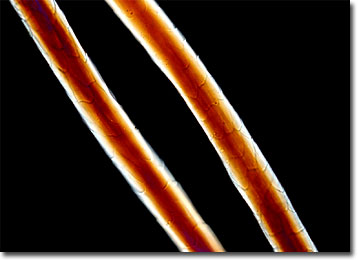Polarized Light Microscopy Digital Image Gallery
Lincoln Sheep Wool
Lincoln sheep are some of the largest sheep in the world, rams reaching weights as great as 350 pounds. These sizable animals also grow exceptionally long, heavy wool, a typical ewe, which may weigh a hundred pounds less than her male counterpart, producing as much as 20 pounds of fleece in a single season.

The Lincoln sheep originated in the Lincolnshire region of East Anglia, England several thousand years ago and is believed by some to be the parent of all other longwool sheep breeds in that country. However, the modern Lincoln was developed through a crossing of the early Lincolnshire native with the English Leicester sometime around the mid-eighteenth century, resulting in an animal with a higher quality wool and improved meat production. Many welcomed this change in the breed, but some breeders were disgruntled by the alteration. Nevertheless, it was this new Lincoln that was soon exported to a number of other countries around the world, including the United States, where the animal first appeared near the end of the 1700s.
Coarse, but lustrous, the wool of the Lincoln sheep is well suited for a number of applications, especially those that require a fiber of high tensile strength and a soft handle. Some of the common uses of the material include specialty knitting yarns, upholstery yarns, and hand-knitted carpet yarns. When these yarns are woven into cloth, they create a textile with impressive durability and brightness. Lincoln wool has also been utilized for many years by the wig industry, which utilizes the long fibers to create shiny, healthy-looking hairpieces for both dolls and humans.
